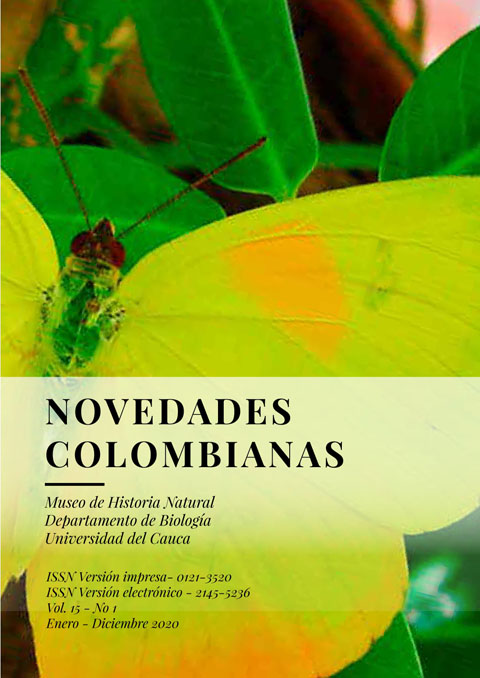Bibliographic review High fructose intake and liver damage
Abstract
Currently, the intake of nutrients in the diet is characterized by the content of high levels of fructose, a monosaccharide found in fruits and widely used artificially as a sweetener, present in a wide variety of processed products, generating, together with saturated fats , an increase in the caloric content of food. This high caloric content in which fructose contributes considerably, has been identified as the cause of metabolic disorders. Although sugars are a necessary source of immediate energy, their consumption often exceeds energy expenditure, favoring the synthesis of fatty acids, a process carried out by the liver; This organ is a metabolic regulation center and despite its compensatory mechanisms, the intake of fructose in high amounts and for prolonged periods of time can lead to tissue damage, so it is important to elucidate the mechanisms of liver damage that are They are reflected in the loss of functionality. Therefore, the objective of this literature review is to document the relationship of high fructose intake with liver impairment.
Downloads
References
Asgharpour, A., Cazanave, S., Pacana, T., Seneshaw, M., Vincent, R., & Banini, B. (2016). A diet-induced animal model of non-alcoholic fatty liver disease and hepatocellular cancer. Journal of Hepatology, 65(3), 579–588. https://doi.org/10.1016/j.jhep.2016.05.005.A
Chukijrungroat, N., Khamphaya, T., Weerachayaphorn, J., Songserm, T., & Saengsirisuwan, V. (2017). Hepatic FGF21 mediates sex differences in high-fat high-fructose diet-induced fatty liver. American Journal of Physiology - Endocrinology and Metabolism, 313(2), E203–E212. https://doi.org/10.1152/ajpendo.00076.2017
Cydylo, M., Davis, A., & Kavanagh, K. (2017). Fatty Liver Promotes Fibrosis In Monkeys Consuming High Fructose. Obesity (Silver Spring), 25(2), 139–148. https://doi.org/10.1016/j.physbeh.2017.03.040
Ganz, M., Bukong, T., Csak, T., Saha, B., Park, J. K., Ambade, A., … Szabo, G. (2015). Progression of non-alcoholic steatosis to steatohepatitis and fibrosis parallels cumulative accumulation of danger signals that promote inflammation and liver tumors in a high fat-cholesterol-sugar diet model in mice. Journal of Translational Medicine, 13(1), 1–14. https://doi.org/10.1186/s12967-015-0552-7
Gissen, P., & Arias, I. M. (2015, October 1). Structural and functional hepatocyte polarity and liver disease. Journal of Hepatology. Elsevier. https://doi.org/10.1016/j.jhep.2015.06.015
Hajifathalian, K., Torabi Sagvand, B., & McCullough, A. J. (2019). Effect of Alcohol Consumption on Survival in Nonalcoholic Fatty Liver Disease: A National Prospective Cohort Study. Hepatology, 70(2), 511–521. https://doi.org/10.1002/hep.30226
Hintermann, C. (2019). The Many Roles of Cell Adhesion Molecules in Hepatic Fibrosis. Cells, 8(12), 1503. https://doi.org/10.3390/cells8121503
Hintermann, & Christen. (2019). The Many Roles of Cell Adhesion Molecules in Hepatic Fibrosis. Cells, 8(12), 1503. https://doi.org/10.3390/cells8121503
Hirsova, P., Bohm, F., Dohnalkova, E., Nozickova, B., Heikenwalder, M., Gores, G., & Weber, A. (2020). Hepatocyte apoptosis is tumor promoting in murine nonalcoholic steatohepatitis. Cell Death and Disease, 11(2), 1–12. https://doi.org/10.1038/s41419-020-2283-9
Ishak, K. G., Zimmerman, H. J., & Ray, M. B. (2017). Alcoholic Liver Disease: Pathologic, Pathogenetic and Clinical Aspects. Alcoholism: Clinical and Experimental Research, 38(2), 147–161. https://doi.org/10.1111/j.1530-0277.1991.tb00518.x
Krishnan, A., Abdullah, T. S., Mounajjed, T., Hartono, S., McConico, A., White, T., … Charlton, M. (2017a). A longitudinal study of whole body, tissue, and cellular physiology in a mouse model of fibrosing NASH with high fidelity to the human condition. American Journal of Physiology - Gastrointestinal and Liver Physiology, 312(6), G666–G680. https://doi.org/10.1152/ajpgi.00213.2016
Krishnan, A., Abdullah, T. S., Mounajjed, T., Hartono, S., McConico, A., White, T., … Charlton, M. (2017b). A longitudinal study of whole body, tissue, and cellular physiology in a mouse model of fibrosing NASH with high fidelity to the human condition. American Journal of Physiology - Gastrointestinal and Liver Physiology, 312(6), G666–G680. https://doi.org/10.1152/ajpgi.00213.2016
Li, J., Liu, H., Mauer, A. S., Lucien, F., Raiter, A., Bandla, H., … Malhi, H. (2019). Characterization of Cellular Sources and Circulating Levels of Extracellular Vesicles in a Dietary Murine Model of Nonalcoholic Steatohepatitis. Hepatology Communications, 3(9), 1235–1249. https://doi.org/10.1002/hep4.1404
Liss, K., McCommis, K., Chambers, K., Pietka, T., Schweitzer, G., Park, S., … Finck, B. (2016). The impact of diet-induced hepatic steatosis in a murine model of hepatic ischemia-reperfusion injury. Liver Transpl, 24(7), 1–21. https://doi.org/10.1038/nbt.3301.Mammalian
Lozano, I., Van Der Werf, R., Bietiger, W., Seyfritz, E., Peronet, C., Pinget, M., … Dal, S. (2016). High-fructose and high-fat diet-induced disorders in rats: Impact on diabetes risk, hepatic and vascular complications. Nutrition and Metabolism, 13(1), 1–13. https://doi.org/10.1186/s12986-016-0074-1
Luo, Y., Burrington, C., Graff, E., Zhang, J., Judd, R., Suksaranjit, P., … Greene, M. (2016). Metabolic phenotype and adipose and liver features in a high-fat western diet-induced mouse model of obesity-linked NAFLD. American Journal of Physiology - Endocrinology and Metabolism, 310(6), E418–E439. https://doi.org/10.1152/ajpendo.00319.2015
Mai, B., & Yan, L. J. (2019). The negative and detrimental effects of high fructose on the liver, with special reference to metabolic disorders. Diabetes, Metabolic Syndrome and Obesity: Targets and Therapy, 12, 821–826. https://doi.org/10.2147/DMSO.S198968
Muhammad, A. (2019). Non-alcoholic fatty liver disease, an overview. Integrative Medicine, 18(2), 42–49.
Ozkan, H., & Yakan, A. (2019). Dietary high calories from sunflower oil, sucrose and fructose sources alters lipogenic genes expression levels in liver and skeletal muscle in rats. Annals of Hepatology, 18(5), 715–724. https://doi.org/10.1016/j.aohep.2019.03.013
Panasevich, M., Meers, G., Linden, M., Booth, F., Perfield, J., Fritsche, K., … Rector, R. (2018). High-fat, high-fructose, high-cholesterol feeding causes severe NASH and cecal microbiota dysbiosis in juvenile ossabaw swine. American Journal of Physiology - Endocrinology and Metabolism, 314(1), E78–E92. https://doi.org/10.1152/ajpendo.00015.2017
Pérez, P., Gutiérrez, J., Ciro, L., Balcazar, N., & Cardona, G. (2020). High fructose diet-induced obesity worsens post-ischemic brain injury in the hippocampus of female rats. Nutritional Neuroscience, 0(0), 1–15. https://doi.org/10.1080/1028415X.2020.1724453
Rahman, K., Desai, C., Iyer, S., Thorn, N., Kumar, P., Liu, Y., … Anania, F. A. (2017). Loss of Junctional Adhesion Molecule A Promotes Severe Steatohepatitis in Mice on a Diet High in Saturated Fat, Fructose, and Cholesterol. Gastroenterology, 151(4), 733–746. https://doi.org/10.1053/j.gastro.2016.06.022.Loss
Ribeiro, A., Igual, M., Santos, E., & Sokal, E. (2019). Childhood Fructoholism and Fructoholic Liver Disease. Hepatology Communications, 3(1), 44–51. https://doi.org/10.1002/hep4.1291
Santhekadur, P., Kumar, D., & Sanyal, A. (2018). Preclinical models of non-alcoholic fatty liver disease. Journal of Hepatology, 68(2), 230–237. https://doi.org/10.1016/j.jhep.2017.10.031
Seki, K., Kitade, M., Nishimura, N., Kaji, K., Asada, K., Namisaki, T., … Yoshiji, H. (2018). Oral administration of fructose exacerbates liver fibrosis and hepatocarcinogenesis via increased intestinal permeability in a rat steatohepatitis model. Oncotarget, 9(47), 28638–28651. https://doi.org/10.18632/oncotarget.25587
Sullivan, J., Le, M., Pan, Z., Rivard, C., Love-Osborne, K., Robbins, K., … Sundaram, S. S. (2015). Oral fructose absorption in obese children with non-alcoholic fatty liver disease. Pediatric Obesity, 10(3), 188–195. https://doi.org/10.1111/ijpo.238
Sun, G., Jackson, C. V., Zimmerman, K., Zhang, L. K., Finnearty, C. M., Sandusky, G. E., … Wang, Y. X. (2019). The FATZO mouse, a next generation model of type 2 diabetes, develops NAFLD and NASH when fed a Western diet supplemented with fructose. BMC Gastroenterology, 19(1), 1–11. https://doi.org/10.1186/s12876-019-0958-4
Ter Horst, K., & Serlie, M. (2017). Fructose consumption, lipogenesis, and non-alcoholic fatty liver disease. Nutrients. https://doi.org/10.3390/nu9090981
Tsuchida, T., Lee, Y., Fujiwara, N., Ybanez, M., Allen, B., Martins, S., … Chou, H. (2017). A Simple Diet- and Chemical-Induced Murine NASH Model with Rapid Progression of Steatohepatitis, Fibrosis and Liver Cancer. Physiology & Behavior, 176(3), 139–148. https://doi.org/10.1016/j.physbeh.2017.03.040
Wang, M. J., Chen, F., Lau, J. T. Y., & Hu, Y. P. (2017, May 18). Hepatocyte polyploidization and its association with pathophysiological processes. Cell Death & Disease. Nature Publishing Group. https://doi.org/10.1038/cddis.2017.167




.png)



